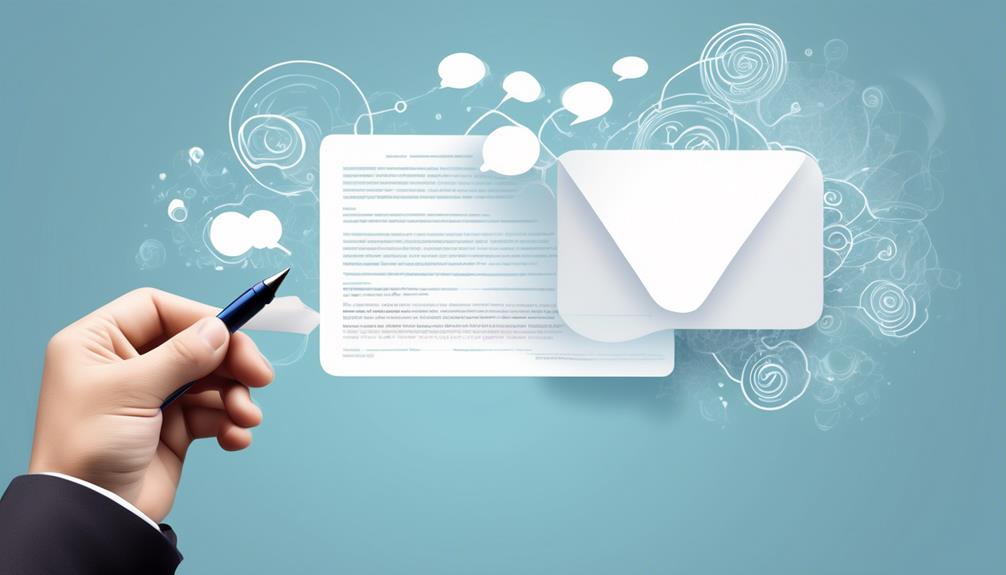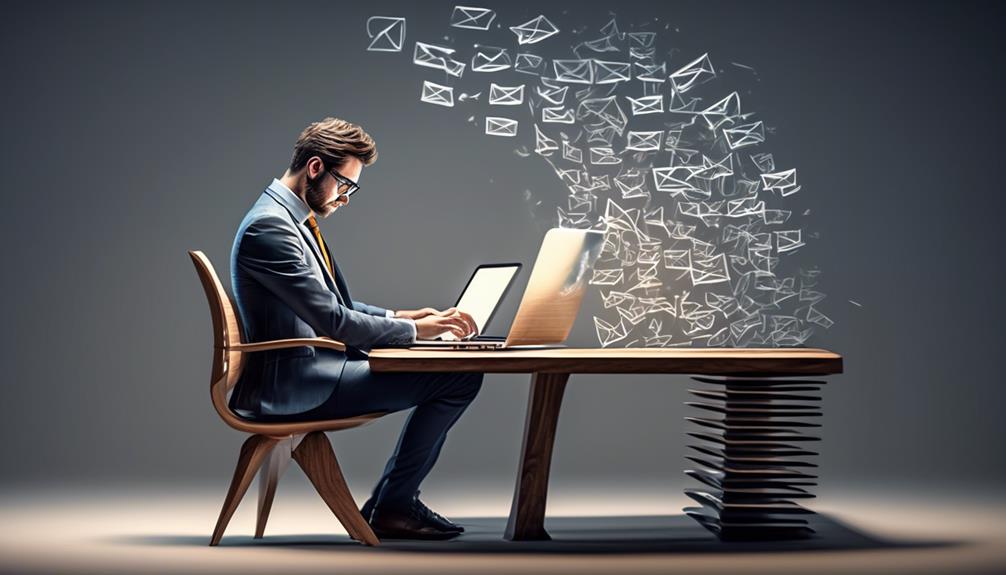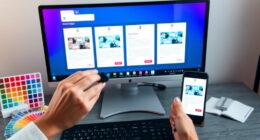Writing a follow-up email to a professor is like carefully maneuvering through a challenging situation. It’s important to find the right balance, demonstrating respect while ensuring your message is noticed and not ignored.
We've all been there—agonizing over the perfect timing and phrasing for that crucial follow-up email. But fear not, because we've got some tried and true strategies that will help you navigate this delicate process with finesse.
So, if you've ever found yourself hesitating before hitting that 'send' button, wondering if your email will get the attention it deserves, then keep on reading.
Key Takeaways
- Send the follow-up email promptly, within 24-48 hours after the meeting or event.
- Be specific and clear in the subject line to communicate the purpose of the follow-up email.
- Express gratitude and reference the specific topic or request discussed in the previous email in the opening.
- Provide an update on the progress, reiterate important points, and request additional information or clarification in the body of the email.
When to Send the Follow-Up Email
After a meeting or event with the professor, it's important to send a follow-up email in a timely manner to express gratitude and recap any discussed topics. This demonstrates professionalism and appreciation for the time the professor has dedicated to meeting with us.
The timing of the follow-up email is crucial. It should be sent promptly after the meeting while the discussion is still fresh in our minds, typically within 24-48 hours. This shows the professor that we value their time and are proactive in our communication.
Additionally, a follow-up email should be sent after submitting an assignment or application, when seeking feedback or information, or after a period of time with no response. It's important to consider the professor's schedule and workload when determining the timing of the follow-up email.
We should also be considerate and avoid bombarding the professor with follow-up emails. It's crucial to wait for an appropriate amount of time before sending a follow-up email, especially if no response has been received. This demonstrates patience and respect for the professor's time.
Crafting the Email Subject Line

Crafting an effective email subject line for a follow-up message to a professor requires careful consideration and attention to detail. The subject line serves as the first impression and can significantly impact whether your email gets opened promptly or not. It is essential to make the subject line specific to the purpose of the follow-up email, using clear and concise language. Including relevant keywords related to the subject matter can also help grab the professor's attention. Moreover, avoiding generic or vague subject lines is crucial to ensure that the recipient understands the content and purpose of the email. Additionally, the subject line should effectively communicate the urgency or importance of your email, prompting the professor to prioritize it accordingly. Below is a table summarizing the key points to consider when crafting the subject line for a follow-up email to a professor.
| Key Considerations | Example |
|---|---|
| Be Specific | "Follow-up on Research Proposal" |
| Use Clear and Concise Language | "Request for Meeting Time" |
| Communicate Urgency/Importance | "Time-Sensitive Inquiry" |
Opening and Addressing the Email
Upon reviewing our previous communications, I'd like to express my gratitude for your time and consideration in assisting me with my academic endeavors. When writing emails to professors, it's important to make sure the opening and addressing of the email are respectful and professional. Here are some important points to consider:
- Start your email with a polite greeting, such as 'Dear Professor [Last Name],' or 'Hello Professor [Last Name],'
- Express appreciation for the professor's time and input in your previous interactions.
- Reference the specific topic or request discussed in your previous email, for example, 'I am following up on the email I sent a few days ago requesting your assistance with [specific topic].'
- Clearly state the purpose of your follow-up email and how you hope this email finds the professor well.
Body of the Email and Request

We appreciate your ongoing support and guidance and would like to provide an update on our progress with the project we previously discussed.
In our efforts to ensure that the professor is well-informed, we wanted to send a polite, professional email as a follow-up.
Firstly, we'd like to reiterate the important points from our previous conversation regarding the project timeline, objectives, and deliverables.
Additionally, we wanted to request additional information or clarification on certain aspects to ensure that we're moving in the right direction.
We understand the importance of allowing a sufficient amount of time for you to address our request, and we're patient and willing to wait for your response.
We believe that your insights and feedback are crucial for the success of this project.
If there's anything else you require from us to facilitate this process, please don't hesitate to let's know.
We greatly appreciate your time and consideration, and we're looking forward to your guidance as we move forward with the project.
Closing and Sign-off
Have you considered the most appropriate closing and sign-off for your email to the professor? When sending a follow-up email to a professor, it's crucial to choose a closing and sign-off that reflect professionalism and gratitude.
Here are some tips for closing and sign-off in your email:
- Choose a respectful closing, such as 'Sincerely,' 'Best regards,' or 'Thank you.'
- Use a professional and appropriate sign-off that matches the level of formality in your email.
- Always include your full name after the sign-off.
- Consider adding any relevant contact information, such as your email or phone number.
In addition to these tips, it's essential to ensure that the closing and sign-off reflect your gratitude and professionalism in the email. By following these guidelines, you can effectively end an email to your professor on a positive note.
Remember that a well-crafted follow-up email can serve as a polite and professional way to express your continued interest in the subject matter and look forward to hearing back from the professor.
Frequently Asked Questions
How Do You Politely Follow up on an Email?
We politely follow up on an email by expressing gratitude for the previous communication.
We reiterate the purpose of our initial message.
We politely inquire about the status or next steps.
It's important to be respectful of the recipient's time and workload, and to avoid being pushy or demanding.
A courteous tone and clear, concise language can help ensure that our follow-up email is well-received and effectively conveys our message.
How Do You Remind a Professor to Reply to an Email?
We understand the importance of following up with professors. When reminding a professor to reply to an email, we suggest being polite and respectful.
It's essential to acknowledge their busy schedule and express understanding of their time constraints. A gentle reminder can be sent after a reasonable wait period, ensuring that the tone remains courteous.
This approach demonstrates professionalism and consideration for the professor's workload.
How Do You Email a Professor About Catching Up?
When emailing a professor about catching up, we should express our specific reason for wanting to meet and suggest a few possible meeting times.
It's important to be respectful of the professor's time and availability.
We can also briefly mention any relevant updates or developments since our last interaction.
Keeping the email concise and to the point will demonstrate consideration for the professor's busy schedule.
How Long to Wait Before Following up on an Email Professor?
We typically wait for a reasonable period after the initial email before following up with a professor. The timing hinges on the context, such as after a meeting or assignment submission. Avoid assuming response time and consider the professor's schedule.
When we do follow up, we ensure our email conveys politeness, respect, and clear purpose, while expressing appreciation for the professor's time.
Can the etiquette for follow-up emails to professors be applied to follow-up emails after job fairs?
Navigating post-networking communication is crucial. Applying the same meticulous etiquette for follow-up emails to professors ensures a professional tone in followup email strategies for job fairs. Politeness, brevity, and a clear call to action can transition a brief exchange into a powerful career opportunity.
Conclusion
In conclusion, just like a well-timed symphony reaching its crescendo, sending a follow-up email to a professor requires patience and precision.
Knowing when to reach out, crafting a compelling subject line, and respectfully addressing the email can all contribute to a harmonious exchange of communication.
By following these steps, we can ensure that our follow-up emails resonate with professionalism and consideration.









